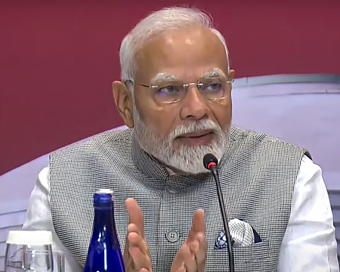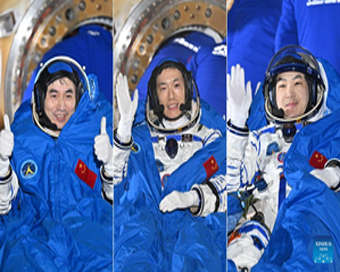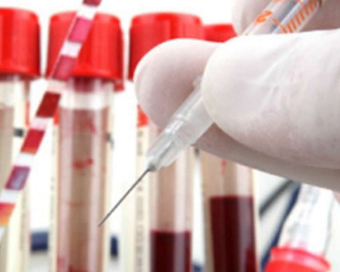 PM Modi visit USA
PM Modi visit USA Only the mirror in my washroom and phone gallery see the crazy me : Sara Khan
Only the mirror in my washroom and phone gallery see the crazy me : Sara Khan Karnataka rain fury: Photos of flooded streets, uprooted trees
Karnataka rain fury: Photos of flooded streets, uprooted trees Cannes 2022: Deepika Padukone stuns at the French Riviera in Sabyasachi outfit
Cannes 2022: Deepika Padukone stuns at the French Riviera in Sabyasachi outfit Ranbir Kapoor And Alia Bhatt's Wedding Pics - Sealed With A Kiss
Ranbir Kapoor And Alia Bhatt's Wedding Pics - Sealed With A Kiss Oscars 2022: Every Academy Award Winner
Oscars 2022: Every Academy Award Winner Shane Warne (1969-2022): Australian cricket legend's life in pictures
Shane Warne (1969-2022): Australian cricket legend's life in pictures Photos: What Russia's invasion of Ukraine looks like on the ground
Photos: What Russia's invasion of Ukraine looks like on the ground Lata Mangeshkar (1929-2022): A pictorial tribute to the 'Nightingale of India'
Lata Mangeshkar (1929-2022): A pictorial tribute to the 'Nightingale of India' PM Modi unveils 216-feet tall Statue of Equality in Hyderabad (PHOTOS)
PM Modi unveils 216-feet tall Statue of Equality in Hyderabad (PHOTOS)The Badminton Association of India (BAI) has announced a 14-member-strong India squad for
- Men’s Sr Hockey Nationals to be played in division-based format from April 4
- Mensik denies Djokovic 100th title in Miami final
- KIPG: Son of a vegetable vendor, Bihar’s Jhandu Kumar eyes Worlds, 2028 Paralympics
- Hardik Singh credits hard work and team unity for receiving HI Midfielder of the Year award
- Djokovic, Alcaraz land in same half of Miami draw
Three Chinese astronauts returned to Earth safely in the early morning Last Updated : 04 Nov 2024 11:44:39 AM IST 
3 Chinese astronauts return to Earth after spending 192 days at Tiangong space station The Shenzhou-18 crew consisting of three Chinese astronauts returned to Earth safely in the early morning on Monday, after completing a six-month mission at Tiangong space station.
Shenzhou-18's return capsule, carrying astronauts Ye Guangfu, Li Cong, and Li Guangsu, touched down at the Dongfeng landing site in north China's Inner Mongolia Autonomous Region at 1:24 a.m. (Beijing Time). The crew had all left the return capsule by 2:15 a.m., according to the China Manned Space Agency (CMSA), Xinhua news agency reported.
The three astronauts, after staying in orbit for 192 days, were all in good health and the Shenzhou-18 manned mission was a success, the CMSA said.
Ye, the Shenzhou-18 mission commander, has become the first Chinese astronaut with an accumulative spaceflight time of more than a year, setting a new record for the longest duration of stay in orbit by a Chinese astronaut.
He served as a crew member in the Shenzhou-13 mission from October 2021 to April 2022.
"Chinese astronauts have flown to space in successive missions. I believe that the record of the duration in orbit will be broken in the near future," Ye said.
China launched the Shenzhou-18 manned spaceship on April 25. During the mission, the Shenzhou-18 crew utilised the scientific experiment cabinets and extravehicular payloads to carry out dozens of experiments in the fields of basic physics in microgravity, space material science, space life science, space medicine, and space technology.
They replaced the burner for the gas experiment in the combustion experiment cabinet and test samples in the fluid physics experiment cabinet as planned. They also conducted in-orbit training on spacecraft rendezvous and docking.
The Shenzhou-18 astronauts carried out extravehicular activities twice. Their first spacewalk in May set a new record for the longest single spacewalk by Chinese astronauts.
Assisted by the space station's robotic arm and a team on Earth, they worked for about eight-and-a-half hours during their first extravehicular activities and completed multiple tasks, including the installation of space debris protection devices.
The crew also carried out emergency decision-making research. By utilising the computer and corresponding software, they completed a series of assessments, including tests on basic cognitive ability, risk perception, decision-making style, as well as comprehensive decision-making tasks.
The ground personnel then used the test results to thoroughly evaluate the astronauts' emergency decision-making ability in orbit and study the influence of factors such as the duration of stay in orbit, emotional state, and workload on their ability.
During the mission, the crew also conducted regular medical check-ups as required, including routine examinations and dynamic monitoring of the heart rate and blood pressure. These procedures helped comprehensively monitor the astronauts' physical state.
The Shenzhou-18 trio also created a space "aquarium" using zebrafish and algae to study how the space environment affects their growth and system balance. It was also a breakthrough in the field of raising vertebrates in space.
The astronauts discovered that zebrafish exhibited abnormal orientation behaviors in microgravity, such as upside-down swimming, spinning, and circling.
Scientists will later utilise the returned water samples, fish eggs, and other specimens, in conjunction with videos of the zebrafish's spatial movement behaviours, to conduct research on the impact of the space environment on the growth, development, and behaviour of vertebrates and to provide support for the study of material cycling in a closed space ecosystem.
The Shenzhou-18 astronauts were also busy cultivating plants in the "space garden" during their stay in orbit. They grew two types of plants -- cherry tomatoes and lettuce.
"Being able to eat fresh vegetables in space is truly a blessing. These green plants have also brought a touch of green and good cheer to our busy work," Li said.
In 2025, China's manned space programme will launch the Shenzhou-20 and Shenzhou-21 crewed missions, and the Tianzhou-9 cargo craft for in-orbit supplies, the CMSA said.IANS Beijing For Latest Updates Please-
Join us on
Follow us on








172.31.16.186







